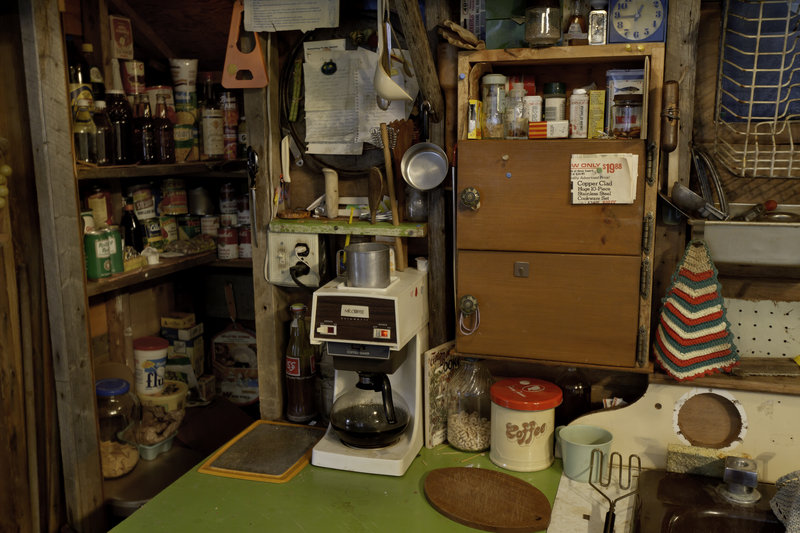Anyone who owns a cabin in the woods or visits a rustic hunting camp on a regular basis understands the concept of making do with what you’ve got.
If the faucet leaks — if you even have water — you jerry-rig a quick solution that involves more than duct tape but something considerably less than new plumbing fixtures. If there’s a hole in the wall, you plug it with something that is not meant to last forever but will get you through the winter.
Even if these temporary interventions are intended to be stopgap, they often end up as perfectly functional long-term solutions.
That ingenuity provides the motive behind Ethan Hayes-Chute’s latest installation, “Stopgap and Steadfast,” at the Center for Maine Contemporary Art in Rockport.
For this piece, Hayes-Chute riffs on a theme of self-sufficiency, self-preservation and self-exclusion. He has created a life-sized, site-specific installation of a small cabin from found and recycled materials and outfitted it with modest furnishings.
“Stopgap and Steadfast” is an offshoot of “Hermitage,” a fully-realized two-story hermit’s hut that occupied the center of the Great Hall during the 2009 Portland Museum of Art Biennial.
This one isn’t as grand, but it invites a more detailed look-see. The cutout kitchen of a backwoods cabin includes a wood stove, a sink piled with breakfast dishes and a small pantry stocked with the kinds of canned foods that you would expect to find in a hard-to-reach hunting shack.
Hayes-Chute, 29, has parlayed this cabin theme into a well-traveled career as a contemporary artist. He is a graduate of Freeport High School, class of 2000, and Rhode Island School of Design, class of ’04. He built his first cabin installation at a gallery in Berlin, his adopted city, in 2008. He did the PMA project in 2009, and last year made an outdoor piece built around large pine trees in the south of France.
There was another in Norway, the country. There was also a residency in Iceland, and later this year he will travel to Morocco, where he has been invited to create a structure for a biennial.
All that, and the Maine Arts Commission named him Visual Arts Fellow for 2011, an honor that carries a large cash stipend.
“It means a lot,” Hayes-Chute said last week. “It’s a great acknowledgement and a nod from the state. It was a surprise to me when I found out. I was quite thrilled, and it’s definitely helped. It enabled me to do some relatively mundane things, like buy a new computer and a camera. It eased my concern about money.
“I still have to work for money, but it allows me to be a little less worried about buying some materials. I can buy this tool to do this job and not worry about it, because I have some money.”
Most of the materials that Hayes-Chute uses for his cabin recreations are recycled. He hunts dumps, scrapyards and flea markets.
The concept for these cabins evolved from earlier work. A few years ago, Hayes-Chute made paintings and small sculptures of little houses — and we’re talking really small, as in an inch or so tall. That’s when he began thinking about the concept of living off the grid, which these installations embody.
“I was doing these paintings and sculptures, but was frustrated that I couldn’t get inside the places,” he said “Even if they were three-dimensional, I could see inside but could not fit inside. I wanted to bring it up to human scale.”
In doing so, Hayes-Chute creates an environment that allows visitors to participate in a sensory way. We’re not just imagining this place — we can feel it.
With the CMCA piece, you walk on the kitchen floor, peek into the pantry and observe the dirty dishes stacked in the sink. Hayes-Chute’s details are impressive. An avowed fan of breakfast cereal, he includes a lonely, water-logged Cheerios nugget floating in a dirty bowl.
In real life, he says, “I am usually not guilty of leaving any in a bowl.” But doing so here makes the installation feel authentic and credible.
Other details include crumpled-up candy wrappers and jars of nasty cleaning solution under the sink.
If you didn’t know this was art, you would swear it was transplanted from the Maine woods.
Further, it’s not hard to imagine a place like this becoming a showpiece in a museum a few hundred years from now. The Museum of Fine Arts in Boston has its period rooms from Colonial New England. This is a period piece from rural Maine, circa mid-1980s.
That was about the time that Hayes-Chute made his earliest visits to a family cabin on Sebec Lake in central Maine. His family has a century-old camp up there, as well as a hunting cabin nearby.
Hayes-Chute’s artistic renderings are not meant to replicate the family place. But the references are undeniable.
“There is not a time period, at least not down to a specific year,” he says of the CMCA installation. “But I imagine it as an old or older, but still-contemporary, cabin. It’s been around a long time.”
“Stopgap and Steadfast” also includes recent drawings and small-scale wall structures.
Staff Writer Bob Keyes can be contacted at 791-7457 or at:
bkeyes@pressherald.com
Twitter: twitter.com/pphbkeyes
Send questions/comments to the editors.



